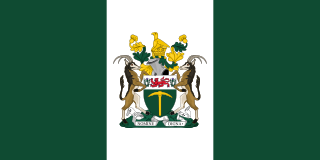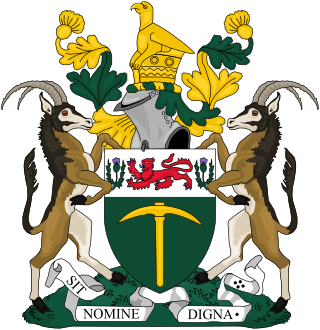This article needs additional citations for verification .(May 2013) |
The following lists events that happened during 1948 in Southern Rhodesia .
This article needs additional citations for verification .(May 2013) |
The following lists events that happened during 1948 in Southern Rhodesia .

Rhodesia, officially from 1970 the Republic of Rhodesia, was an unrecognised state in Southern Africa from 1965 to 1979, equivalent in territory to modern Zimbabwe. Rhodesia was the de facto successor state to the British colony of Southern Rhodesia, which had been self-governing since achieving responsible government in 1923. A landlocked nation, Rhodesia was bordered by South Africa to the south, Bechuanaland to the southwest, Zambia to the northwest, and Mozambique to the east. From 1965 to 1979, Rhodesia was one of two independent states on the African continent governed by a white minority of European descent and culture, the other being South Africa.

Ian Douglas Smith was a Rhodesian politician, farmer, and fighter pilot who served as Prime Minister of Rhodesia from 1964 to 1979. He was the country's first leader to be born and raised in Rhodesia, and led the predominantly white government that unilaterally declared independence from the United Kingdom in November 1965 in opposition to the UK's demands for the implementation of majority rule as a condition for independence. His 15 years in power were defined by the country's international isolation and involvement in the Rhodesian Bush War, which pitted Rhodesia's armed forces against the Soviet- and Chinese-funded military wings of the Zimbabwe African National Union (ZANU) and Zimbabwe African People's Union (ZAPU).

Northern Rhodesia was a British protectorate in Southern Africa, now the independent country of Zambia. It was formed in 1911 by amalgamating the two earlier protectorates of Barotziland-North-Western Rhodesia and North-Eastern Rhodesia. It was initially administered, as were the two earlier protectorates, by the British South Africa Company (BSAC), a chartered company, on behalf of the British Government. From 1924, it was administered by the British Government as a protectorate, under similar conditions to other British-administered protectorates, and the special provisions required when it was administered by BSAC were terminated.

Southern Rhodesia was a landlocked self-governing British Crown colony in southern Africa, established in 1923 and consisting of British South Africa Company (BSAC) territories lying south of the Zambezi River. The region was informally known as south Zambesia until annexed by Britain at the behest of Cecil Rhodes's British South Africa Company, for whom the colony was named. The bounding territories were Bechuanaland (Botswana), Northern Rhodesia (Zambia), Portuguese Mozambique (Mozambique), and the Transvaal Republic.

The Southern Rhodesian Liberal Party was a political party in Southern Rhodesia, founded in 1943 by Jacob Smit (1881–1959), the former United Party (UP) Minister of Finance. It is thought that Smit split from the UP largely because Prime Minister Sir Godfrey Martin Huggins had failed to include him in the exclusive Second World War Defence Committee.

Rhodesia, known initially as Zambesia, is a historical region in southern Africa whose formal boundaries evolved between the 1890s and 1980. Demarcated and named by the British South Africa Company (BSAC), which governed it until the 1920s, it thereafter saw administration by various authorities. It was bisected by a natural border, the Zambezi. The territory to the north of the Zambezi was officially designated Northern Rhodesia by the company, and has been Zambia since 1964; that to the south, which the company dubbed Southern Rhodesia, became Zimbabwe in 1980. Northern and Southern Rhodesia were sometimes informally called "the Rhodesias".
Simon Ramsay, 16th Earl of Dalhousie,, styled The Honourable Simon Ramsay between 1928 and 1950, was a British land owner, Scottish Unionist Party politician and colonial governor.

The pound was the currency of Southern Rhodesia. It also circulated in Northern Rhodesia and Nyasaland. The pound was subdivided into 20 shillings, each of 12 pence.
The following lists events that happened during 1924 in the Colony of Southern Rhodesia.

The Rhodesia Labour Party was a political party which existed in Southern Rhodesia from 1923 until the 1950s. Originally formed on the model of the British Labour Party from trade unions and being especially dominated by railway workers, it formed the main opposition party from 1934 to 1946. The party suffered a catastrophic split during the Second World War and lost all its seats, and a further split over the attitude to the Federation of Rhodesia and Nyasaland ended its involvement in Rhodesian politics.

Lieutenant-Colonel Henry Breedon Everard was a railway engineer and executive who briefly became the Acting President of Rhodesia on three occasions between 1975 and 1979.
General elections were held in Southern Rhodesia on 15 September 1948. They saw Prime Minister Godfrey Huggins regain the overall majority he had lost in the previous elections in 1946. Huggins' United Party won a landslide, reducing the opposition Liberal Party to a small minority.

The prime minister of Zimbabwe was a political office in the government of Zimbabwe that existed on two occasions. The first person to hold the position was Robert Mugabe from 1980 to 1987 following independence from the United Kingdom. He took office when Southern Rhodesia became the Republic of Zimbabwe on 18 April 1980. This position was abolished when the constitution was amended in 1987 and Mugabe became president of Zimbabwe, replacing Canaan Banana as the head of state while also remaining the head of government. The office of prime minister was restored in 2009 and held by Morgan Tsvangirai until the position was again abolished by the 2013 Constitution of Zimbabwe.

The Southern Rhodesia Communist Party was an illegal, underground communist party established in Southern Rhodesia which was formed in large part due to the minority settler rule, which had an immensely repressive structure. It emerged in 1941 from a split in the Rhodesia Labour Party. The party consisted of a small, and predominantly white, membership. During the parties existence it had links to other communist parties such as the Communist Party of South Africa and the Communist Party of Great Britain. The party disappeared in the late 1940s, with the exact date of its dissolution not being known. Nobel Laureate Doris Lessing author of various works including “The Grass is Singing,” is the most well known member of the Southern Rhodesian Communist Party.

The Federation of Rhodesia and Nyasaland, also known as the Central African Federation (CAF), was a colonial federation that consisted of three southern African territories: the self-governing British colony of Southern Rhodesia and the British protectorates of Northern Rhodesia and Nyasaland. It existed between 1953 and 1963.
The Reformed Industrial Commercial Union (RICU) was a trade union in Southern Rhodesia during the 1940s and 1950s.
During the late 19th century and early 20th century, a number of South African and British political leaders advocated for a Greater South Africa. This irredentism can be regarded as an early form of Pan-Africanism, albeit strictly limited to White Africans of European ancestry.

General elections were held in Northern Rhodesia on 14 August 1948.
Jacob Hendrik Smit, CMG was a Southern Rhodesian merchant and politician. Born in the Netherlands, Smit migrated to Rhodesia and traded as a merchant, before becoming Southern Rhodesia's Minister of Finance in 1933. Orthodox in his economic policies, Smit resigned from Godfrey Huggins' government in 1942 and later formed the right-wing Liberal Party. He was Southern Rhodesia's Leader of the Opposition from 1946 to 1948, when he lost his seat.
Harold Hardwicke Clake Holderness was a lawyer and liberal politician in Southern Rhodesia, who was also a highly decorated wartime RAF Coastal Command pilot.